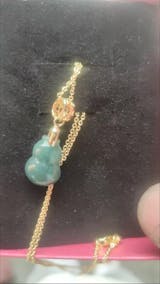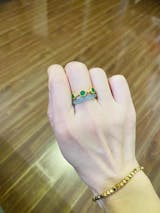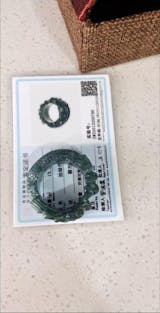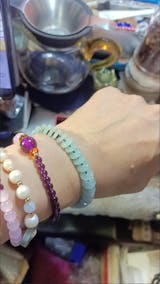Hamsa Hand Meaning: Symbolism, Origins, and Modern Spiritual Use
In this article, we’ll explore the deep meaning and symbolism of the Hamsa Hand, tracing its origins across different cultures and religions. You'll discover what the Hamsa represents spiritually, how it’s used for protection and blessings, and why it remains a popular symbol in modern-day spirituality and personal expression. Whether you're new to spiritual symbols or looking to deepen your understanding, this guide will help you connect with the meaning and magic of the Hamsa.

What Is the Hamsa Hand?
The Hamsa Hand (also spelled Khamsa or Chamsa) is an ancient symbol recognized across many cultures and religions. Featuring an open palm with an eye in the center, the Hamsa is believed to offer protection against negative energies, especially the evil eye, and bring blessings, strength, and good fortune.
The Meaning of the Hamsa Hand
At its core, the Hamsa Hand symbolizes protection, power, and positive energy. The central eye is said to watch over and ward off harmful influences. The five fingers of the hand represent the five senses, which, when working in harmony, can help guard against evil.
Depending on its orientation:
- Upward (fingers up): Acts as a symbol of protection, particularly against the evil eye, jealousy, and hatred.
- Downward (fingers down): Invites abundance, fertility, and answered prayers.

Origins and Cultural Background
The Hamsa Hand has a rich and diverse history. Its name comes from the Arabic word khamsa, meaning "five," which refers to the five fingers of the hand.
- Middle Eastern and North African roots: The Hamsa is widely used in Islamic and Jewish traditions.
- Islamic culture: Often called the "Hand of Fatima," it is associated with Fatima Zahra, the daughter of Prophet Muhammad, symbolizing faith, patience, and loyalty.
- Jewish culture: Referred to as the "Hand of Miriam," it is linked to Miriam, the sister of Moses and Aaron, and represents protection and divine presence.
The symbol predates both religions, with roots in Phoenician and Mesopotamian artifacts, where it was used as a protective amulet against evil forces.
The Hamsa and the Evil Eye
The evil eye is a malicious glare—often driven by envy or ill intent—believed to bring misfortune, illness, or even death to its target. This belief is common across many cultures, from the Middle East and Mediterranean to South Asia and Latin America.
The Hamsa Hand is widely recognized as a powerful talisman used to ward off the evil eye and other forms of negative energy. The eye symbol, often placed at the center of the palm, plays a crucial role in its protective power. It is believed to reflect and neutralize the harmful gaze, acting like a spiritual shield.
Many Hamsa designs incorporate a blue eye, as blue is traditionally considered the most potent color for protection against the evil eye. This shade symbolizes spiritual strength, peace, and healing.
In particular, the open right hand—a key feature of the Hamsa—is a universal symbol of protection, blessing, power, and strength. Across various cultures and traditions, the raised open palm is seen as a spiritual gesture that blocks negative forces and welcomes divine energy. By combining the hand and the eye, the Hamsa becomes a multifaceted symbol of defense, attracting blessings while pushing away harm.

Modern Usage of the Hamsa Hand
Today, the Hamsa Hand is more than just a symbol—it's a versatile icon that blends spirituality, art, and personal expression. While rooted in ancient traditions, its use has evolved to fit modern lifestyles and aesthetics, making it a popular choice in both sacred and everyday contexts.
Jewelry:
The Hamsa is commonly worn as hamsa hand necklaces, bracelets, earrings, rings, and even anklets, often combined with other symbols like the evil eye or healing crystals. Many people wear Hamsa jewelry not only for its protective qualities but also as a reminder to stay mindful, balanced, and spiritually grounded. Whether made from gold, silver, or gemstones, these pieces are often gifted to convey love, protection, and blessings.
Home Decor:
The Hamsa Hand is a staple in bohemian, Middle Eastern, and spiritual home decor styles. It is often:
- Hung at the entrance of a home to protect the space from harmful energies.
- Placed in bedrooms, living rooms, or offices to promote peace, safety, and positive vibes.
- Designed as wall art, tapestries, ceramic tiles, wind chimes, or incense holders.
Many interior decorators incorporate the Hamsa for both its visual appeal and its symbolic ability to create a calm, protective atmosphere.

Fashion and Accessories:
Hamsa prints are also popular in modern clothing, such as T-shirts, scarves, bags, and yoga gear. They are especially favored by those who identify with boho, hippie, or new age styles. The symbol serves both as a fashion statement and a badge of spiritual awareness.
Spiritual and Wellness Practices:
In the world of yoga, Reiki, energy healing, and meditation, the Hamsa Hand is often used as a visual focal point or amulet. It is believed to help align the chakras, protect the aura, and invite blessings from the universe. It may appear on altar setups, journals, crystals, or affirmation cards as part of daily rituals.
Hamsa Hand Tattoos:
The Hamsa is a powerful and deeply personal tattoo choice, often inked as a symbol of:
- Protection from negative energy
- Spiritual awakening
- Inner strength and resilience
- Faith and divine guidance
Hamsa tattoos are often combined with other elements such as mandalas, lotus flowers, or script in Arabic, Hebrew, or Sanskrit, enhancing both their aesthetic and spiritual meaning.

Conclusion
The Hamsa Hand is a powerful spiritual symbol with centuries of cultural and religious significance. Whether worn as jewelry, displayed in the home, or used in meditation, the Hamsa continues to offer a sense of protection, positivity, and peace in the modern world.
Related Articles:
Explore 6 Crystals for Evil Eye Protection
Best Jewelry for Protection and Strength from Evil
Protection Bracelet: Meaning, Benefits, and Types



























































